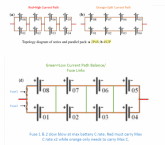I was getting ready to post the exact same question! Sorry to hijack... 4S2P (creating cell pairs, then wiring the cells in series) feels right, but I purchased my cell used I won't be able to monitor individual voltage to make sure I'm not over charging a single cell. Because of that I considered wiring them as 2 individual 4S1P and then running those two sets in parallel. I think this would give me better over sight, but doesn't seem as tidy (are there any other concerns doing this?). My 3rd thought was to do the latter initially and when I see that everything is good to go, switch to a 4S2P setup. Again, sorry to hijack ? but I leave for a trip in 2 days, so today is the decision day. Any thoughts would be greatly appreciated! Thanks, Andreas





